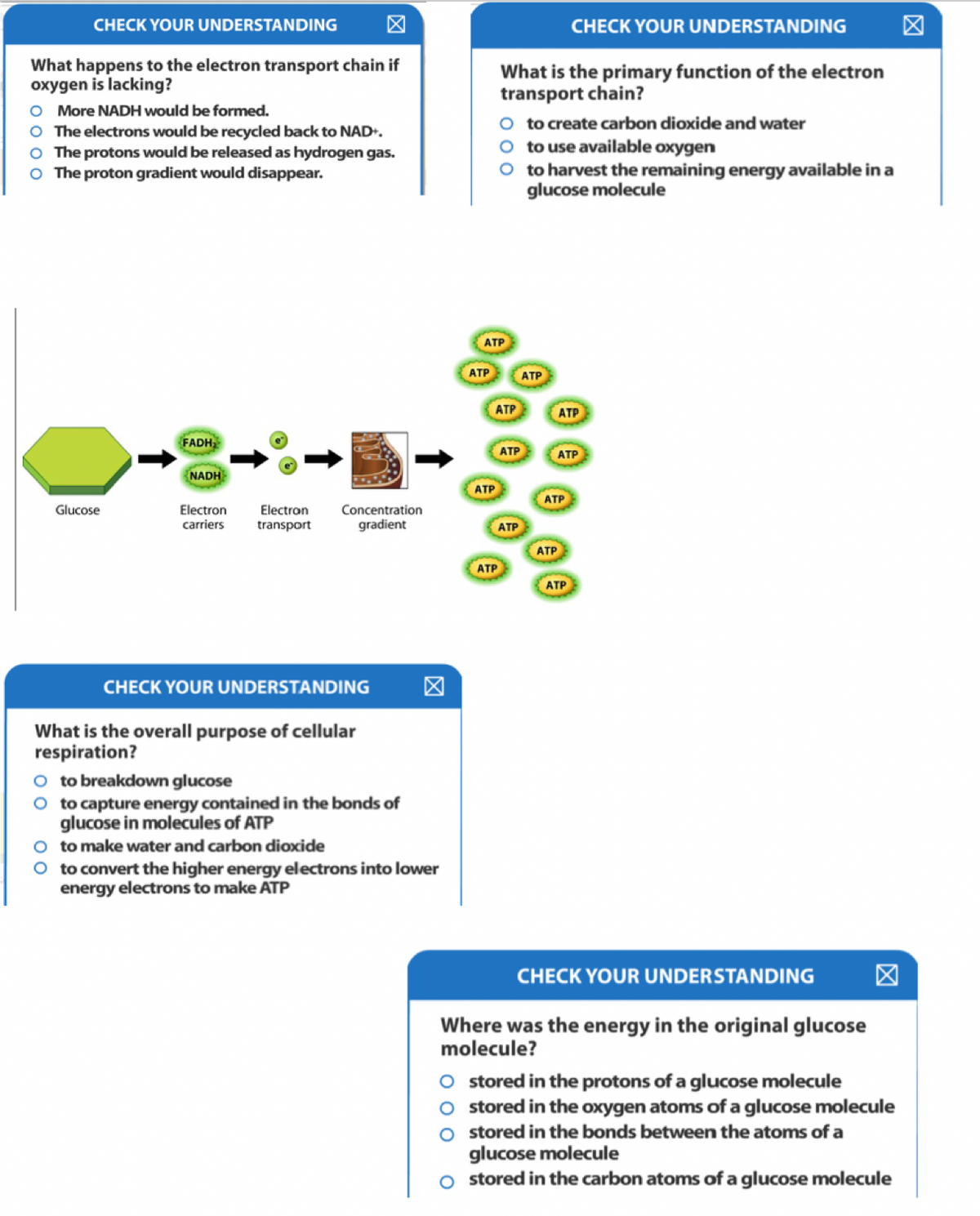What happens to the electron transport chain if oxygen is lacking? O More NADH would be formed. O The electrons would be recycled back to NAD+. O The protons would be released as hydrogen gas. O The proton gradient would disappear.
What happens to the electron transport chain if oxygen is lacking? O More NADH would be formed. O The electrons would be recycled back to NAD+. O The protons would be released as hydrogen gas. O The proton gradient would disappear.
Biology: The Dynamic Science (MindTap Course List)
4th Edition
ISBN:9781305389892
Author:Peter J. Russell, Paul E. Hertz, Beverly McMillan
Publisher:Peter J. Russell, Paul E. Hertz, Beverly McMillan
Chapter7: Cellular Respiration: Harvesting Chemical Energy
Section: Chapter Questions
Problem 4TYK
Related questions
Question

Transcribed Image Text:CHECK YOUR UNDERSTANDING
区
CHECK YOUR UNDERSTANDING
区
What happens to the electron transport chain if
oxygen is lacking?
What is the primary function of the electron
transport chain?
More NADH would be formed.
to create carbon dioxide and water
O The electrons would be recycled back to NAD+.
O The protons would be released as hydrogen gas.
O The proton gradient would disappear.
to use available oxygen
to harvest the remaining energy available in a
glucose molecule
ATP
ATP
ATP
ATP
ATP
FADH2
ATP
ATP
NADH
ATP
ATP
Glucose
Electron
Electron
Concentration
carriers
transport
gradient
ATP
ATP
ATP
ATP
CHECK YOUR UNDERSTANDING
What is the overall purpose of cellular
respiration?
O to breakdown glucose
O to capture energy contained in the bonds of
glucose in molecules of ATP
O to make water and carbon dioxide
O to convert the higher energy electrons into lower
energy electrons to make ATP
CHECK YOUR UNDERSTANDING
区
Where was the energy in the original glucose
molecule?
O stored in the protons of a glucose molecule
stored in the oxygen atoms of a glucose molecule
o stored in the bonds between the atoms of a
glucose molecule
o stored in the carbon atoms of a glucose molecule
0 00
Expert Solution
This question has been solved!
Explore an expertly crafted, step-by-step solution for a thorough understanding of key concepts.
This is a popular solution!
Trending now
This is a popular solution!
Step by step
Solved in 3 steps

Knowledge Booster
Learn more about
Need a deep-dive on the concept behind this application? Look no further. Learn more about this topic, biology and related others by exploring similar questions and additional content below.Recommended textbooks for you

Biology: The Dynamic Science (MindTap Course List)
Biology
ISBN:
9781305389892
Author:
Peter J. Russell, Paul E. Hertz, Beverly McMillan
Publisher:
Cengage Learning

Biochemistry
Biochemistry
ISBN:
9781305577206
Author:
Reginald H. Garrett, Charles M. Grisham
Publisher:
Cengage Learning

Anatomy & Physiology
Biology
ISBN:
9781938168130
Author:
Kelly A. Young, James A. Wise, Peter DeSaix, Dean H. Kruse, Brandon Poe, Eddie Johnson, Jody E. Johnson, Oksana Korol, J. Gordon Betts, Mark Womble
Publisher:
OpenStax College

Biology: The Dynamic Science (MindTap Course List)
Biology
ISBN:
9781305389892
Author:
Peter J. Russell, Paul E. Hertz, Beverly McMillan
Publisher:
Cengage Learning

Biochemistry
Biochemistry
ISBN:
9781305577206
Author:
Reginald H. Garrett, Charles M. Grisham
Publisher:
Cengage Learning

Anatomy & Physiology
Biology
ISBN:
9781938168130
Author:
Kelly A. Young, James A. Wise, Peter DeSaix, Dean H. Kruse, Brandon Poe, Eddie Johnson, Jody E. Johnson, Oksana Korol, J. Gordon Betts, Mark Womble
Publisher:
OpenStax College

Biology (MindTap Course List)
Biology
ISBN:
9781337392938
Author:
Eldra Solomon, Charles Martin, Diana W. Martin, Linda R. Berg
Publisher:
Cengage Learning